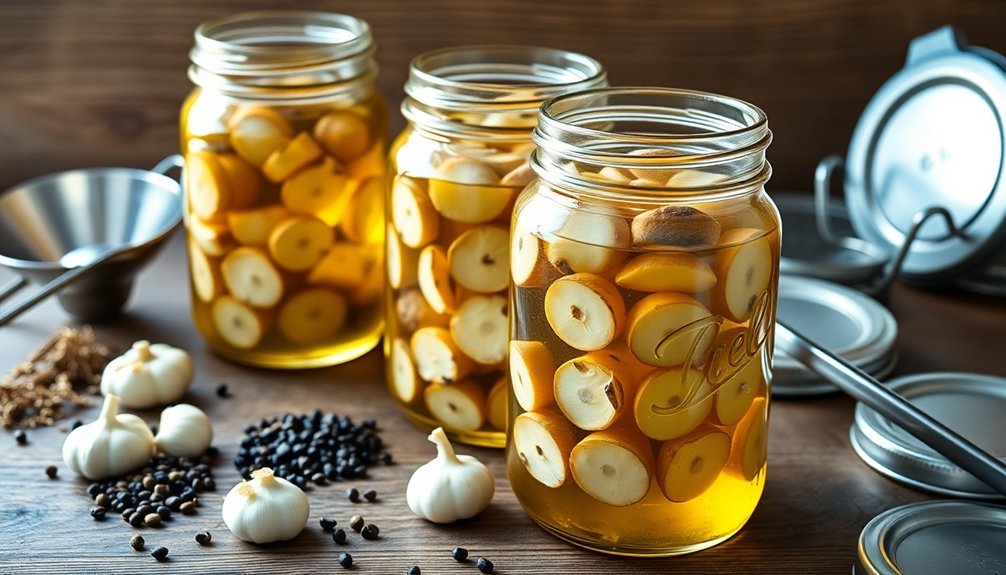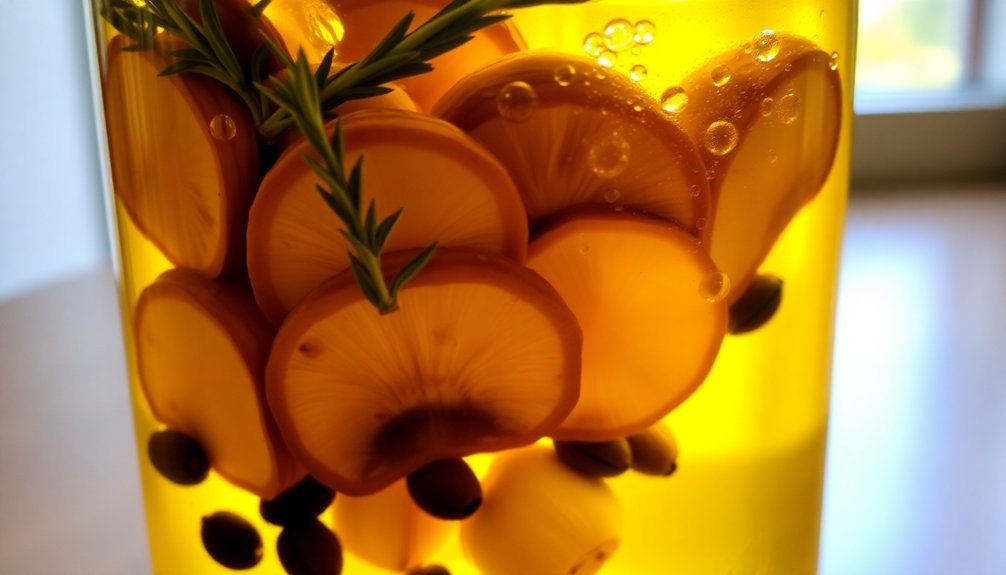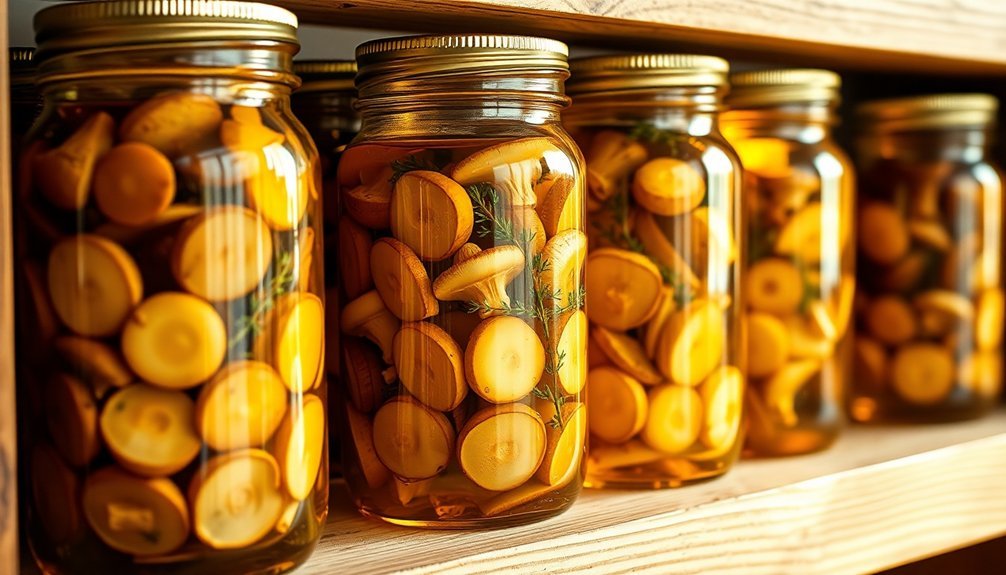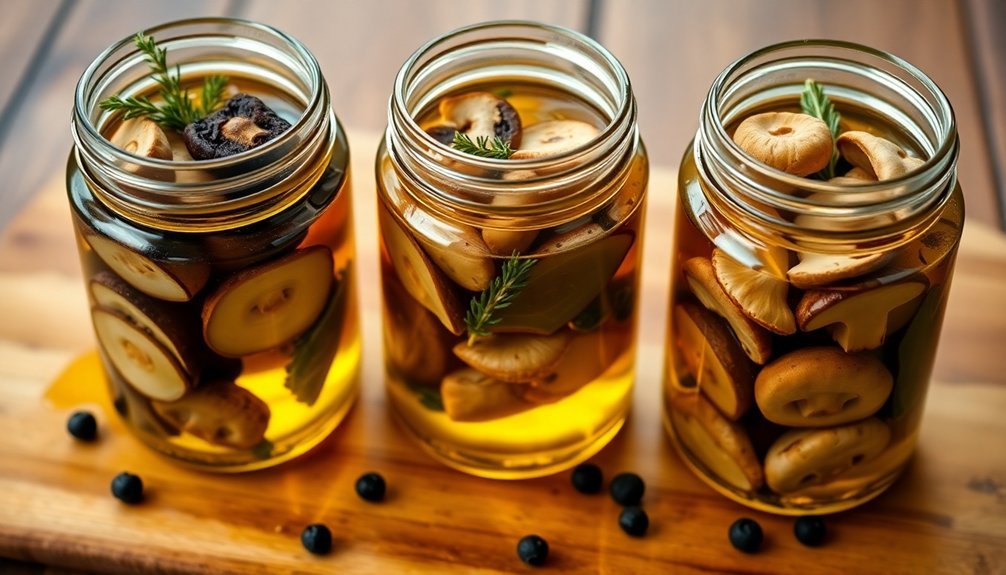You'll find success preserving mushrooms in oil through seven proven methods: hot pack preservation, cold pack storage, herb infusion, alcohol intermediary technique, heated maceration, traditional maceration, and pressure canning. Start by cleaning fresh, unblemished mushrooms with a damp cloth and slice them uniformly. You'll need sterilized jars, quality oil (olive or avocado), and complementary herbs like thyme or rosemary. Maintain proper temperatures between 50-70°F during storage and watch for signs of spoilage. Whether you're a novice or experienced preserver, these time-tested techniques will help you master the art of mushroom preservation.
Essential Equipment and Ingredients

A well-equipped kitchen is your starting point for preserving mushrooms in oil. You'll need sterilized jars to prevent contamination and guarantee your preserved mushrooms remain safe for consumption.
A heavy skillet or saucepan is essential for sautéing mushrooms and heating your chosen oil. Select firm mushroom varieties that can withstand the preservation process without becoming mushy. If you're planning for long-term storage, consider investing in a vacuum sealer to remove air from your containers.
For the preservation process, you'll want to select high-quality oils like extra virgin olive oil or rapeseed oil. These oils not only preserve but also enhance the mushrooms' flavor.
You'll need to heat the oil to infuse flavors and create an anaerobic environment, then allow it to cool before filling your jars to prevent thermal shock.
Don't forget your flavoring ingredients. Garlic, rosemary, thyme, and black pepper are traditional choices that complement mushrooms beautifully. You can also incorporate vinegar or lemon juice for additional preservation properties.
Salt is vital both for flavor and preservation, while optional ingredients like maple syrup, onions, or pimiento can create unique flavor profiles.
Remember to maintain a clean workspace and use sterile utensils throughout the process to guarantee food safety.
Preparing Fresh Mushrooms
Fresh mushrooms require careful preparation before they can be preserved in oil. Start by gently cleaning your mushrooms with a damp cloth or paper towel, removing any visible dirt or debris.
Don't wash them under running water, as they'll absorb too much moisture, which can lead to spoilage during preservation. Some mushrooms like hen of the woods can go straight to preservation raw.
Once cleaned, slice your mushrooms uniformly, keeping them no thicker than 1/4 inch. This consistent sizing guarantees even cooking and proper preservation. For larger mushrooms, you'll want to quarter them to maintain size consistency throughout your batch.
The next vital step is blanching or cooking the mushrooms. You've got several effective options:
- Blanch in boiling water for 2 minutes, followed by an ice bath
- Steam-blanch for 5 minutes (slices) or 9 minutes (quarters)
- Sauté in a small amount of oil until lightly browned
- Cool quickly after cooking to halt the cooking process
Before moving to the preservation stage, verify that your mushrooms are completely dry.
Work in small batches and sterilize all your containers and utensils. This preparation phase is essential for successful preservation and maintaining the mushrooms' quality over time.
Herb-Infused Oil Methods

When infusing oils for mushroom preservation, selecting the right combination of herbs can dramatically enhance both flavor and shelf life. You'll want to choose herbs that complement mushroom flavors, like thyme, rosemary, or garlic, guaranteeing they're clean and contaminant-free. Due to safety concerns, all herb and oil mixtures must be refrigerated.
For dry herbs, use a 1:5 to 1:8 ratio, while fresh herbs require a 1:2 to 1:4 ratio.
You've got three effective methods to choose from. The basic maceration method involves submerging your herbs in oil within a mason jar for about two weeks in a cool, dark place, shaking occasionally.
If you're short on time, try heated maceration, where you'll warm the mixture at 90-100°F for 2-6 hours or overnight, stirring periodically.
For maximum extraction, you can use the alcohol intermediary method. Mix ground dry herbs with whole grain alcohol or vodka, let it sit for a day, then blend with carrier oil.
Whatever method you choose, strain the mixture through cheesecloth for clarity. Store your finished infused oil in sealed glass containers in a cool, dark place, where it'll keep for 6-12 months.
Always verify the oil completely covers the herbs and check regularly for spoilage signs.
Hot Pack Preservation Technique
You'll need to begin by thoroughly sterilizing all your jars, lids, and utensils in boiling water to prevent any bacterial contamination during the preservation process.
Safe temperature control means maintaining your brine at a consistent simmer (not a rolling boil) while blanching your mushrooms, ensuring they're heated through but not overcooked.
Keep your sterilized equipment warm until use by leaving it in the hot water, removing pieces only as needed during the packing process.
Sterilize Equipment Before Starting
Proper sterilization sets the stage for safely preserving mushrooms in oil. You'll need to thoroughly clean and sterilize all equipment to prevent bacterial growth and contamination that could lead to food poisoning, particularly botulism. Using high temperatures above 100°C (212°F) effectively kills harmful microorganisms and guarantees your preserved mushrooms remain safe for consumption.
Start by preparing your equipment using these essential sterilization steps:
- Wash all jars, lids, and utensils thoroughly to remove any debris or residue.
- Place clean equipment in a pressure cooker or steam sterilizer.
- Heat at the appropriate temperature for the recommended time.
- Allow equipment to dry completely before use to prevent moisture contamination.
When handling your sterilized equipment, you'll want to avoid cross-contamination by using separate utensils for each batch of mushrooms.
Keep your sterilized equipment in a clean, dry environment until you're ready to use it. Remember to label and date your containers once you've completed the preservation process.
During storage, regularly monitor your preserved mushrooms for any signs of spoilage or rancid oil, and always use clean spoons when removing mushrooms from the containers.
Safe Temperature Control Methods
Temperature control throughout the preservation process stands as the cornerstone of safely storing mushrooms in oil. You'll need to carefully monitor heat levels during both the blanching and oil preparation stages to guarantee food safety and maximal preservation.
When blanching your mushrooms, maintain a rolling boil at 212°F (100°C) for exactly 2 minutes before immediately transferring them to an ice bath. This rapid temperature change helps preserve texture while killing harmful microorganisms. If you're using the sautéing method instead, heat your pan until the mushrooms begin to brown but don't let them burn.
For the oil infusion stage, you'll want to heat your oil just enough to release the flavors from your herbs and spices – typically around 180°F (82°C). Don't let it reach smoking point, as this can create off-flavors and reduce preservation effectiveness.
After heating, let the oil cool slightly before combining it with your mushrooms. When filling your jars, verify the mushrooms are at room temperature and completely submerged in the cooled, flavored oil.
You'll need to maintain consistent storage temperatures between 50-70°F (10-21°C) in your pantry or storage area for maximal preservation.
Cold Pack Storage Solutions

Successful cold storage of oil-preserved mushrooms relies heavily on maintaining suitable conditions in your storage space. Your pantry can serve as the perfect location, as it provides the cool, dark environment needed to maximize shelf life and prevent oil rancidity.
You'll want to make certain the area remains dry and away from any direct sunlight to maintain ideal preservation.
To effectively monitor your stored mushrooms, you should routinely check for these critical signs of spoilage:
- Unusual odors or rancid smells coming from the oil
- Visual changes in the mushrooms' appearance or signs of mold
- Texture alterations that differ from the original preservation
- Any evidence of bacterial growth or contamination in the jar
Always use sterilized glass jars with airtight seals for your cold storage solution.
Remember to leave approximately half an inch of headspace at the top of each jar to accommodate natural expansion. When accessing your preserved mushrooms, it's important to use clean utensils to prevent introducing contaminants.
With proper cold storage techniques, you'll be able to enjoy your oil-preserved mushrooms for several months while maintaining their flavor and texture.
Safe Bottling Practices
When bottling mushrooms in oil, you'll need to follow precise sterilization practices to guarantee food safety and prevent bacterial growth. Start by sterilizing all your jars, lids, and utensils using a pressure cooker or boiling water.
Make sure your workspace is clean and sanitized before you begin the preservation process.
As you prepare your mushrooms, wipe them with a damp cloth rather than washing them, as they'll absorb excess water that can lead to spoilage. You'll want to either blanch or sauté the mushrooms to reduce their water content and eliminate harmful bacteria.
Select only fresh, unblemished mushrooms for the best results.
When you're ready to bottle, heat your chosen oil (olive or avocado work well) with your preferred herbs and spices. Fill the sterilized jars with your prepared mushrooms and pour the hot, flavored oil over them, ensuring complete coverage.
Remove any air bubbles by gently tapping the jars and running a clean utensil along the sides. Leave appropriate headspace, then seal the jars tightly.
Store them in a cool, dark place or refrigerate them, and wait at least a week before sampling to allow the flavors to develop fully.
Long-Term Storage Guidelines

For ideal preservation of your oil-bottled mushrooms, proper storage conditions play an essential role in maintaining quality and safety.
You'll want to keep your jars in a cool, dark pantry away from direct sunlight and heat sources. The temperature should remain consistently below room temperature to prevent spoilage and maintain the quality of both the mushrooms and oil.
To monitor your preserved mushrooms effectively, check them regularly for these warning signs:
- Unusual or rancid odors coming from the jar
- Visible mold growth on mushrooms or oil surface
- Changes in mushroom texture or color
- Compromised jar seals or bulging lids
When you're accessing your preserved mushrooms, always use clean utensils to prevent contamination.
Make sure the remaining mushrooms stay fully submerged in oil, and the jar remains tightly sealed after each use.
You can expect your preserved mushrooms to last several months when stored correctly, but it's best to wait at least a week after initial preservation before using them.
The flavored oil itself becomes a valuable cooking ingredient, perfect for various dishes from pasta to salads.
Frequently Asked Questions
Can Different Types of Preserved Mushrooms Be Mixed in the Same Jar?
Yes, you can mix different mushroom varieties in the same jar if they're firm types with similar textures. Stick to combining meaty mushrooms like chanterelles, porcini, and hedgehogs for the best preservation results.
What Signs Indicate the Preserved Mushrooms Have Gone Bad?
You'll know your preserved mushrooms are spoiled if you notice dark spots, mold, sliminess, or detect foul odors. Also watch for unusual mushiness, discoloration, and any rancid smell from the oil.
Is It Safe to Reuse the Flavored Oil After Consuming Mushrooms?
You shouldn't reuse mushroom-infused oil due to bacterial contamination risks. If you've properly acidified it, you can use it within 4 days when refrigerated, but it's safer to discard after the mushrooms are consumed.
How Do Preserved Mushrooms Compare Nutritionally to Fresh Ones?
You'll find preserved mushrooms retain most nutrients, though they may lose some water-soluble vitamins. They're still rich in minerals and can offer extra benefits from infused herbs and spices in the oil.
Can Wine or Vinegar Be Added to Oil-Preserved Mushrooms?
You'll need vinegar for safe preservation – it's crucial to acidify mushrooms before adding oil. While wine isn't suitable as a preservative, you can use it to enhance flavor in the oil mixture.
In Summary
By following these preservation methods, you'll have delicious mushrooms in oil ready to enhance your meals year-round. Remember to always use clean equipment, monitor for any signs of spoilage, and store your preserved mushrooms in a cool, dark place. Whether you've chosen hot pack or cold pack methods, you'll enjoy the rich flavors and textures of your preserved mushrooms for months to come.





Leave a Reply